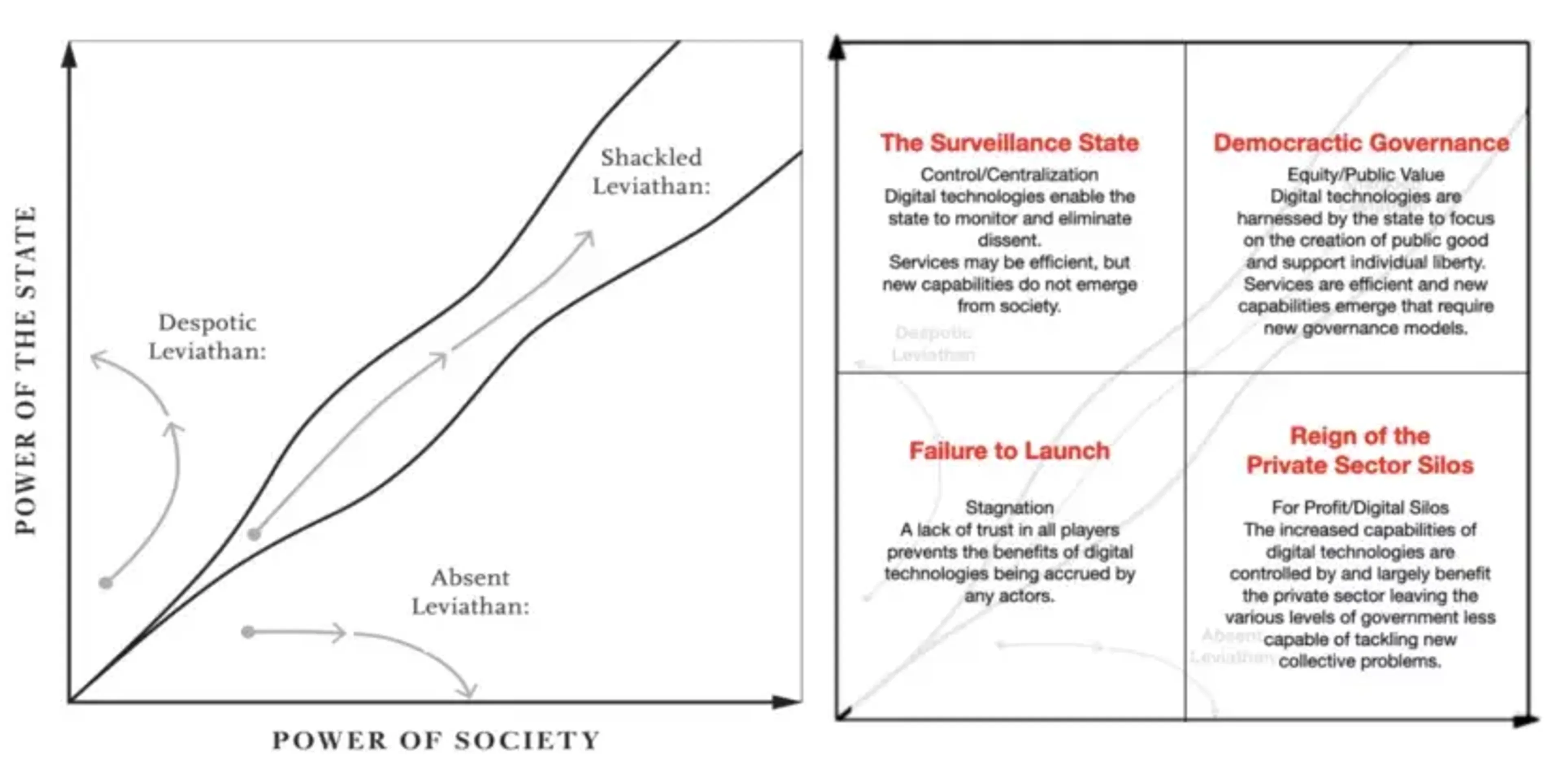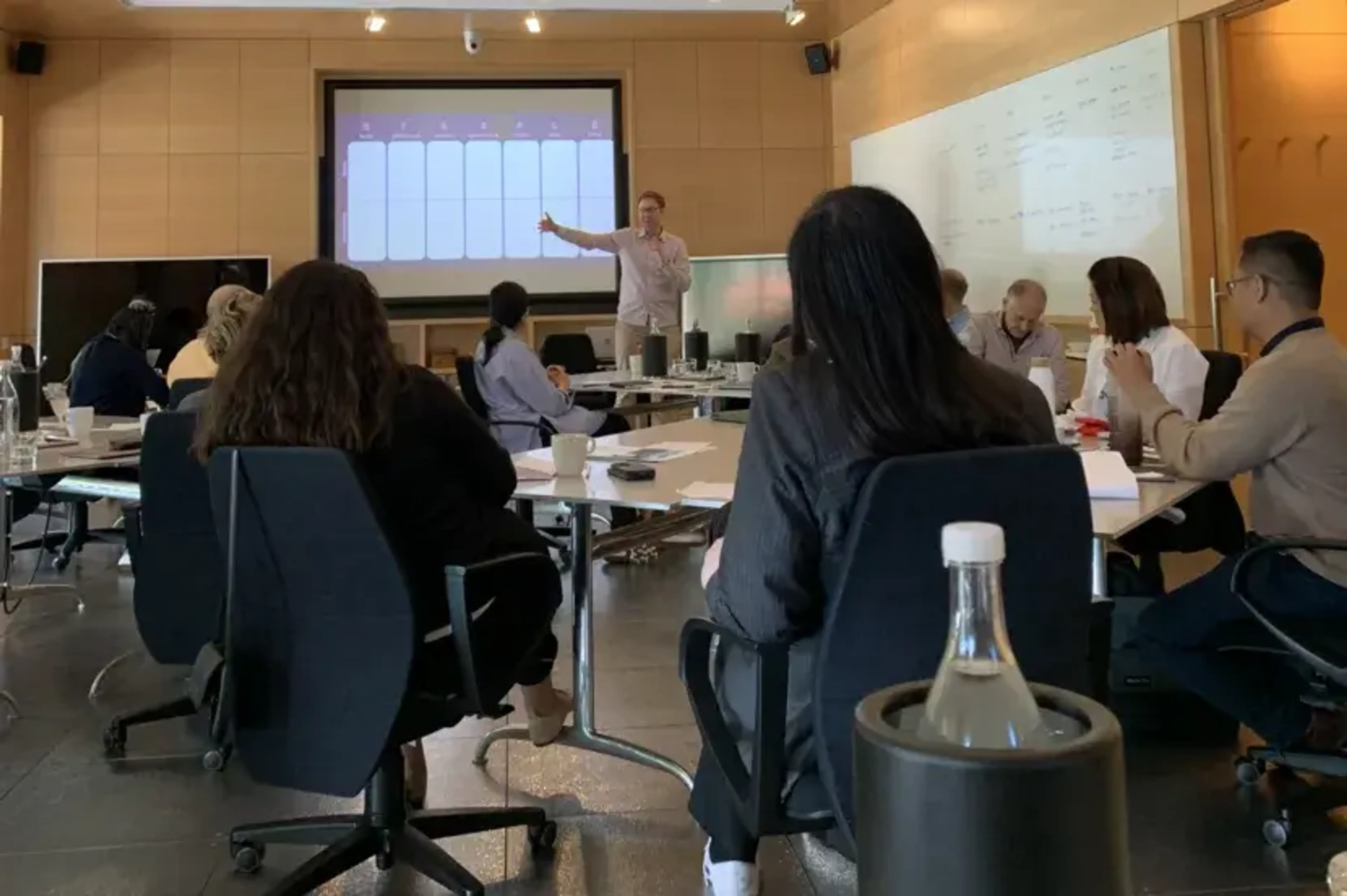
Philippa Elworthy
Director
In June 2022 Public Digital, Harvard Kennedy School, and Co-Develop hosted a convening at the Rockefeller Bellagio Center to discuss the question: How should we shape our collective digital future? Our blog post on the convening and its attendees can be read here.
Below are some personal reflections on the event by Public Digital organiser, Philippa Elworthy.
We designed the discussion at the convening using the framework of the ‘The Narrow Corridor’, a concept introduced by Acemogulu and Robinson in their 2019 book of the same name. The Narrow Corridor refers to a delicate balance between the powers of the state and society, with the central argument being that for liberty to emerge and flourish, both must be strong.
David Eaves, one of our hosts from the Harvard Kennedy School, has translated this framework for the world of digital government: The image below shows four possible scenarios of digital government as aligned with the concept of the narrow corridor. Employing this framework, we invited our attendees to consider the future of digital government and discuss collective action.

At the convening, we heard about recent successes in digital government from around the world, ranging from tools to help measure the impact of digitisation in Bangladesh, to the fantastic work in Ukraine delivering vital public services through their Diia app.
With such extraordinary work being done, the group took some time to reflect on the values that are making this work possible:
People matter. In a world trying to encourage ‘technical’ choices, it is the people you choose and the support you give them that has the biggest impact. Talent must be nurtured and encouraged as part of a multidisciplinary team, people must be given space to fail, and capacity must be created if you want brilliant people to deliver.
Missions matter. In order for digital government to succeed, you need a compelling mission. While that mission can emerge from a crisis, or be set by impactful leadership, the source matters less than whether your mission is at the core of the work you do. It is the importance and eloquence of that mission that will help attract the talent you need.
For all the celebration of the victories of digital government, there was frustration too. The group agreed that we have not yet gone far enough. However, the convening provided a space for us to assess the obstacles, plan ahead, and nurture optimism for the future.

The
range of expertise presented by attendees of the convening enabled us
to build a clear picture of the most common obstacles to functioning
digital government. Here are three key obstacles that resonated from our
discussion:
Government spending is often locked into waterfall budgeting.This does not align with what we know to be successful ways of working i and instead creates a constant struggle between failing fast, learning and iterating, versus the business case demand of fixed expectations. The group recognised that the government as a digital buyer needs to become both more intelligent and more demanding to ensure value for public money.
We tend to regress to the mean. The reduction of bureaucracy during the pandemic enabled significant progress and momentum for change, t leading to a number of success stories. However as time rolls on we see these bureaucratic structures returning in full force. Restoring business-as-usual processes for governance, recruitment and budgeting will only serve to limit further gains made.
We are failing to maximise talent. Given that empowered people and teams are at the centre of successful digital governments, the greatest obstacle identified was the ability to recruit, retain and develop this talent. While this is a challenge for every organisation, governments in particular must get better at getting the most out of their contractors and consultants.
Whilst there is a lot to be learned from the past successes and failures of digital government, our social and political environment is ever changing, and so, in turn, are the challenges we face.
With that in mind, we spent some time looking ahead and examining the trends which are likely to impact digital government in the future. Of the numerous trends we discussed, two stood out most:
Migration: We are seeing an escalation in the root causes of global migration:- conflict, environmental disasters, and economic instability. With increasing migration comes the need for countries to digitally support citizens from afar in order to provide digital identifiers, funding, or support.
Data sovereignty: Our discussions at the
convening drew out a range of views on the topic of data sovereignty. In
the context of the narrow corridor, and privacy in particular, data
sovereignty may be seen as essential for digital government to function
well. However the risks associated with this protectionist approach are
high during times of physical crisis. For example where war or
environmental disaster have led to the destruction of data stores,
privacy and borders will become less of a priority.
Having examined the conditions for success, the obstacles we face, and the projected trends affecting digital government, we considered what this all means within the context of the narrow corridor.
In which direction are we heading on the graph? What impact will these trends have on our ability to stay within the narrow corridor? And, most importantly, what can be done about it?
The group reflected that whilst the problems that come with operating within a surveillance state or under private sector reign are clear, the destabilising impact of stagnation (staying still) cannot and should not be ignored.
We recognised that stagnation comes from three factors: a
lack of trust (where government fails to deliver), inaction, and from
the constraints of existing ways of working. This combination can result
in what feels like a relatively ‘safe’ but un-transformative space. The
reality is that staying still is now the equivalent of moving backwards, and with that comes the very real risk of falling out of the narrow corridor.
Whilst the conversations at the convening ranged from the practical to the strategic, there was a shared appreciation within the group of the value of the conversation itself. The discussion was the first step in tackling the question: where will we go from here?
The group identified two important and actionable gaps to be addressed first in the area of digital government.
Government digital product teams need regular, facilitated opportunities to share their experiences across borders
The structures to enable that sharing need to translate into practice (e.g. sharing of platforms or code)
In
collaboration with the Rockefeller Foundation and Public Digital’s
other partners, we are exploring ways to address these gaps, and we look
forward to sharing our work in the coming months.

Director